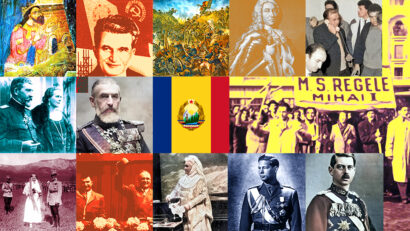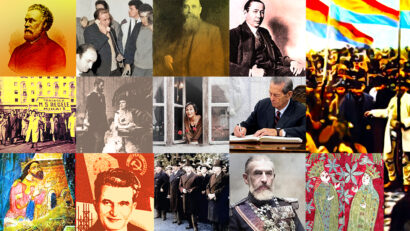The Bolyai University
The Romanian-Hungarian dispute of the 20th Century had, among other components, one related to the academic community, more precisely to the University of Cluj

Steliu Lambru, 25.02.2019, 12:17
Carrying on the tradition of the Jesuit College established in Cluj in 1581 and of the Hungarian-language university set up in 1872, the University of Cluj became a bone of contention especially after Romanians demanded in 1848, the establishment of a Romanian-language academic institution. Their request was not granted at the time. After 1918, when Transylvania joined Romania, the Ferdinand I University was set up in Cluj, while the old university, called Franz Joseph, was moved to Szeged, Hungary, until 1940. When the north of Transylvania was merged into Hungary in August 1940, the Hungarian university returned to its home town. It was the Romanian-language universitys turn to take refuge, in Sibiu, only to come back to Cluj after 1945, when Romania reclaimed Northern Transylvania. In order to meet both demands, the communist authorities decided to have two universities in Cluj, one with Romanian tuition, and called “Victor Babes, after a famous Romanian physician, and another one, with teaching in Hungarian, called “Janos Bolyai to honour a great Hungarian mathematician. In 1959, the two institutions merged into what is today the “Babes-Bolyai University.
Janos Fazekas was one of the leaders of the Hungarian community in the communist years. In a 2002 interview to the Centre of Oral History of the Romanian Radio Broadcasting Corporation, Janos Fazekas said Nicolae Ceausescu is the one responsible for the disappearance of Bolyai University: “Let me tell you about Ceausescus xenophobia. When he started out and included the social and national homogenisation of society into the platform of the communist party, he defined this goal as a forcible assimilation of ethnic minorities and created a unified nation, a new type of nation. He organised the dismantling of the Bolyai University, to which Ion Iliescu, then president of the democratic students, also made a contribution. He organised a National Conference in Cluj, where Romanian and Hungarian students were instructed to request that the two universities be merged, but the actual goal was for the Bolyai University to disappear gradually. And when the National Student Conference was actually held, Ceausescu went and asked Gheorghiu-Dej, ‘Comrade Dej, what are we to do? Students want the two universities unified! And Dej answered, ‘Then lets do what students say, because youth always look ahead, into the future! So Dej embraced the idea, too, and persuaded him to even give a speech at that conference.
Janos Fazekas tried to rescue the Bolyai University, but he failed: “At that time, I was in hospital, in Otopeni. I checked myself out and told Georghiu-Dej: ‘Comrade Dej, how could you make such a mistake?’ Did you forget that back in 1947, when you came back from the signing of the Treaty of Paris and spoke in Oradea you said: ‘We got back Northern Transylvania, but not as a so-called historical right, we didn’t get it back because it has a majority Romanian population, we didn’t get it back because we took part in the late period of the war against Hitler, but we got it back because of the democratic policy of our party, of the Groza government. I told him that, showing him the newspaper that wrote that comrade Dej had an easy job at the Treaty of Paris conference, showing that there was a Hungarian university, another Hungarian language school of medicine in Targu Mures, a fine arts school in Hungarian, and the Hungarian Conservatory in Cluj, we had Hungarian language education.
Erno Gall was a pro-rector of the Bolyai University. In a 1995 interview, he emphasized the difficulties faced by Hungarian language universities in the Stalinist period: “We had these two universities after 1945 in Cluj, and a collaboration was created between them. It was a natural and necessary collaboration, in line with the ideology of their times, an internationalist ideology, which promoted friendship. The professors who taught there lived through the Stalinist period, and after 1949 the rectors of these universities were arrested and convicted in Stalinist trials. We are speaking of physician Ludovic Csogor, rector of the university, and Balogh Edgar, another rector. During those years, the level of teaching fell, they were the years when this university was not much above a grade school, it could not, by any measure, be considered a modern university. To my good fortune, in 1952 to 1953, especially after Stalin’s demise, the situation improved, and the university underwent a period of relative growth and spiritual development. The professors were not changed, they brought in younger staff.
Erno Gall believed the fate of the university he managed was sealed right after the anti-communist revolution of 1956 in Hungary: “The Hungarian revolution followed in 1956 with dramatic and tragic consequences for us, in more ways than one. Following the events in Hungary, the intellectuals in Cluj, writers in particular, became very critical of the status quo. This eventually gave rise to a movement that challenged and condemned previous developments, and, of course, this sense of relative relief influenced students and teachers. Students wrote a memorandum demanding certain rights, and we ended up in a position of opposition. In mind and spirit I sympathised with them, but as pro-rector I had to deal with all these complications and difficulties. The students fought back, and many of them along with many of the teaching staff, young teachers in particular, were arrested in 1957 when the authorities stifled the students movement.
Despite its troubled history, in a century of turmoil, the Babes-Bolyai University is today an icon of multiculturalism, a positive example of how a history of unrest can give rise to something viable.





























